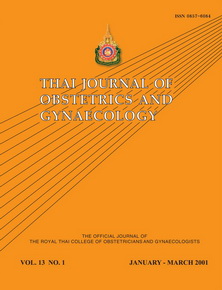The Practice of External Cephalic Version (ECV) and Vaginal Birth after Cesarean Section (VBAC) to reduce Cesarean Section rate in Thailand
Main Article Content
Abstract
Objective To survey the practice of external cephalic version (ECV) and vaginal birth after
cesarean section (VBAC) in Thailand.
Design Cross-sectional study.
Setting All general and private hospitals with more than 200 beds in Thailand.
Subjects Two hundred twenty seven hospitals (119 general hospitals, 9 university hospitals
and 99 private hospitals).
Intervention The postal questionnaires were sent to all general and private hospitals with more
than 200 beds during 1999. The questions asked whether the consultant obstetricians in these
hospitals performed ECV and VBAC. If they practiced, how much their experiences were. If
they had never done these procedures, had they ever seen or known about them.
Main outcome measures The number of the hospitals practicing ECV and VBAC.
Results Overall, 89% of questionnaires were returned. VBAC was performed in 33% of the
hospitals but only 12% out of 33% were intentionally while ECV was perform in 26% of the
hospitals.
Conclusion According to the survey, ECV and VBAC were performed on individual basis with
only small number of cases. Although all obstetricians do not need to perform VBAC and ECV
themselves, each hospital should provide these services for pregnant women who are
considered appropriate for these procedures.
cesarean section (VBAC) in Thailand.
Design Cross-sectional study.
Setting All general and private hospitals with more than 200 beds in Thailand.
Subjects Two hundred twenty seven hospitals (119 general hospitals, 9 university hospitals
and 99 private hospitals).
Intervention The postal questionnaires were sent to all general and private hospitals with more
than 200 beds during 1999. The questions asked whether the consultant obstetricians in these
hospitals performed ECV and VBAC. If they practiced, how much their experiences were. If
they had never done these procedures, had they ever seen or known about them.
Main outcome measures The number of the hospitals practicing ECV and VBAC.
Results Overall, 89% of questionnaires were returned. VBAC was performed in 33% of the
hospitals but only 12% out of 33% were intentionally while ECV was perform in 26% of the
hospitals.
Conclusion According to the survey, ECV and VBAC were performed on individual basis with
only small number of cases. Although all obstetricians do not need to perform VBAC and ECV
themselves, each hospital should provide these services for pregnant women who are
considered appropriate for these procedures.
Article Details
How to Cite
(1)
Chanrachakul, B.; Herabutya, Y. The Practice of External Cephalic Version (ECV) and Vaginal Birth after Cesarean Section (VBAC) to reduce Cesarean Section rate in Thailand. Thai J Obstet Gynaecol 2017, 13, 15-18.
Section
Original Article


